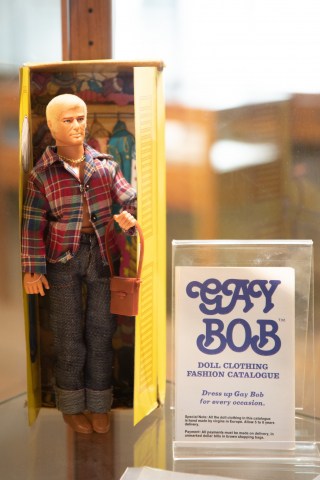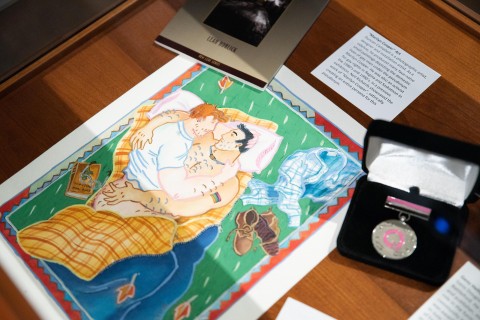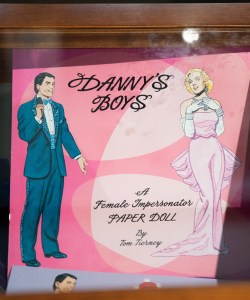This October, students can visit Murray Library to view an exhibit featuring items from one of Canada’s largest LGBTQ+ archives. The Thing I’m Most Proud Of… is an exhibit paying tribute to the life’s work of the late Neil Richards, an activist and retired University of Saskatchewan Library employee.

Gay Bob displayed for the Neil Richards exhibit on the first floor of Murray Library.
Richards began working at the U of S Library in 1972. In 1986, he donated a large amount of materials to the Provincial Archives of Saskatchewan, creating the first public LGBTQ+ archive in Canada. Even after retiring, Richards remained dedicated to the archive, working until his death in January 2018.
Today, the Neil Richards Collection of Sexual and Gender Diversity holds over 8000 titles featuring LGBTQ+ materials that span decades of literature, unique memorabilia and political movements on the Prairies.
Joe Wickenhauser, a U of S alumnus and the executive director of Moose Jaw Pride, notes the importance of Richards’ collection to the LGBTQ+ community as well as the broader public.
“The more time you spend in the archive, the more you realize you need to share those stories with your community because the stories are difficult,” Wickenhauser said. “They’re stories of struggle, and they’re sometimes stories of beauty and victory. But our community hasn’t been telling these stories, and they’ve been hidden, and there’s been so much shame for so long.”
Wickenhauser believes that the works collected will also serve future generations.
“To finally have the opportunity to access those stories, and to tell them and to celebrate them, is really a new thing and a beautiful thing,” Wickenhauser said.
David Bindle, an assistant librarian at the U of S, describes Richards as “a curious and furious collector” whose work has greatly benefited the university.
“It does attract international attention,” Bindle said. “We’ve had donors from the U.K. and all over the States that find this and look at it, and they’re so impressed with it, and they end up actually sending quite valuable materials to us… I think it situates the university here pretty well.”

Various works sit on display on the first floor of Murray Library.
For Wickenhauser, the collection represents Richards’ bravery and foresight.
“The importance of the work that he’s done can’t be understated,” Wickenhauser said. “Neil was participating in activism in the 70s — this is less than ten years after homosexual acts were decriminalized in Canada.”
Wickenhauser notes that, at the time, individuals were losing their jobs and facing social isolation for being in the LGBTQ+ community. Furthermore, Wickenhauser says that Richards’ collection was considered “taboo” material at the time, placing Richards at risk.

An artwork sits on display in the Neil Richards exhibit on the first floor of the Murray Library.
“He housed it in his own home for years and years, until, finally, maybe 20 or 30 years later, an institution recognized the value of the work that he had done. And I think that requires tremendous vision and understanding of the importance of the work that is happening… We have that history because of his work and the risks that he took and the sort of vision that he had.”
For Bindle, the collection also represents a changing society.
“I think there’s been a radical change over the last twenty years… This collection is something that really illuminates how acceptance and inclusivity [have] changed over time, for the better,” Bindle said.
Richards’ efforts to track LGBTQ+ history have resulted in what Bindle describes as “a great resource for somebody who might be also struggling with their sexuality.”
The work generated from Richards’ collection is ongoing as researchers explore the vast archive and his colleagues carry on his work of expanding it.
“He was quite something, and we all miss him,” Bindle said. “He’s going to be hard to forget because he’s left us with a lot of work,” he joked. “[Richards] left us with one of the most prestigious collections in North America.”
Students can view the exhibit on display on the ground floor of Murray Library and in the Link Gallery on the first floor of the Library. Students can also head to the University Library’s website to search through the Neil Richards Collection of Sexual and Gender Diversity online.
—
Raquel Alvarado
Photos: Riley Deacon / Photo Editor